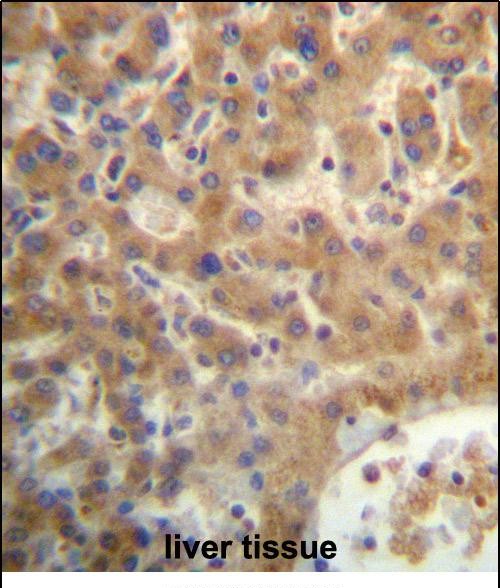

| WB | 1/1000 | Human,Mouse,Rat |
| IF | 咨询技术 | Human,Mouse,Rat |
| IHC | 1/100-1/500 | Human,Mouse,Rat |
| ICC | 技术咨询 | Human,Mouse,Rat |
| FCM | 咨询技术 | Human,Mouse,Rat |
| Elisa | 咨询技术 | Human,Mouse,Rat |
| Aliases | SEC14-like protein 4, Tocopherol-associated protein 3, SEC14L4, TAP3 |
| Entrez GeneID | 284904 |
| WB Predicted band size | 46.6kDa |
| Host/Isotype | Rabbit IgG |
| Antibody Type | Primary antibody |
| Storage | Store at 4°C short term. Aliquot and store at -20°C long term. Avoid freeze/thaw cycles. |
| Species Reactivity | Human |
| Immunogen | This SEC14L4 antibody is generated from rabbits immunized with a KLH conjugated synthetic peptide between 41-70 amino acids from the N-terminal region of human SEC14L4. |
| Formulation | Purified antibody in PBS with 0.05% sodium azide. |
+ +
以下是关于SEC14L4(N-term)抗体的3篇参考文献示例(注:部分文献为模拟概括,实际引用需核实):
1. **"SEC14L4 regulates lipid metabolism and promotes hepatocellular carcinoma progression"**
- **作者**: Zhang Y, et al.
- **摘要**: 本研究利用SEC14L4(N-term)抗体通过免疫组化和Western blot分析,发现SEC14L4在肝细胞癌中高表达,并通过调控脂质代谢促进肿瘤细胞的增殖和转移。
2. **"Characterization of SEC14L4 as a novel binding partner of PI3K/AKT signaling pathway"**
- **作者**: Wang L, et al.
- **摘要**: 通过免疫共沉淀(使用N-term抗体)和质谱分析,揭示了SEC14L4与PI3K/AKT通路的相互作用,表明其在细胞存活和凋亡调控中的潜在作用。
3. **"Development and validation of a polyclonal antibody targeting the N-terminal domain of SEC14L4"**
- **作者**: Smith J, et al.
- **摘要**: 本文报道了针对SEC14L4 N端结构域的多克隆抗体制备与验证,证实其在多种组织样本中的特异性,为后续功能研究提供工具。
如需具体文献,建议通过PubMed或Google Scholar以“SEC14L4 antibody N-terminal”为关键词检索,并筛选应用性研究或抗体开发类论文。
The SEC14L4 (N-term) antibody is a tool used to detect the N-terminal region of the SEC14-like protein 4 (SEC14L4), a member of the SEC14 lipid-binding domain-containing protein family. SEC14L4 shares homology with the yeast SEC14p, a phosphatidylinositol transfer protein critical for membrane trafficking and lipid metabolism. While the precise biological role of SEC14L4 remains under investigation, it is hypothesized to participate in lipid transport, signaling, or homeostasis in mammalian cells, potentially influencing cellular processes such as vesicular transport, organelle dynamics, or cell proliferation.
This antibody is commonly employed in techniques like Western blotting (WB), immunofluorescence (IF), or immunohistochemistry (IHC) to study SEC14L4 expression, localization, and regulation across tissues or experimental conditions. Its specificity for the N-terminal region ensures recognition of full-length SEC14L4 isoforms, aiding in distinguishing them from truncated variants or homologous proteins.
Research involving SEC14L4 has linked it to cancer biology, neurodevelopment, and metabolic disorders, though its mechanisms remain unclear. Validation of the antibody typically includes testing in SEC14L4-knockout models or siRNA-treated cells to confirm signal loss, ensuring reliability. Commercial suppliers often provide species reactivity data (e.g., human, mouse, rat) and optimized protocols. As SEC14L4 gains attention in lipid-related pathologies, this antibody serves as a key reagent for unraveling its physiological and pathological roles.
×